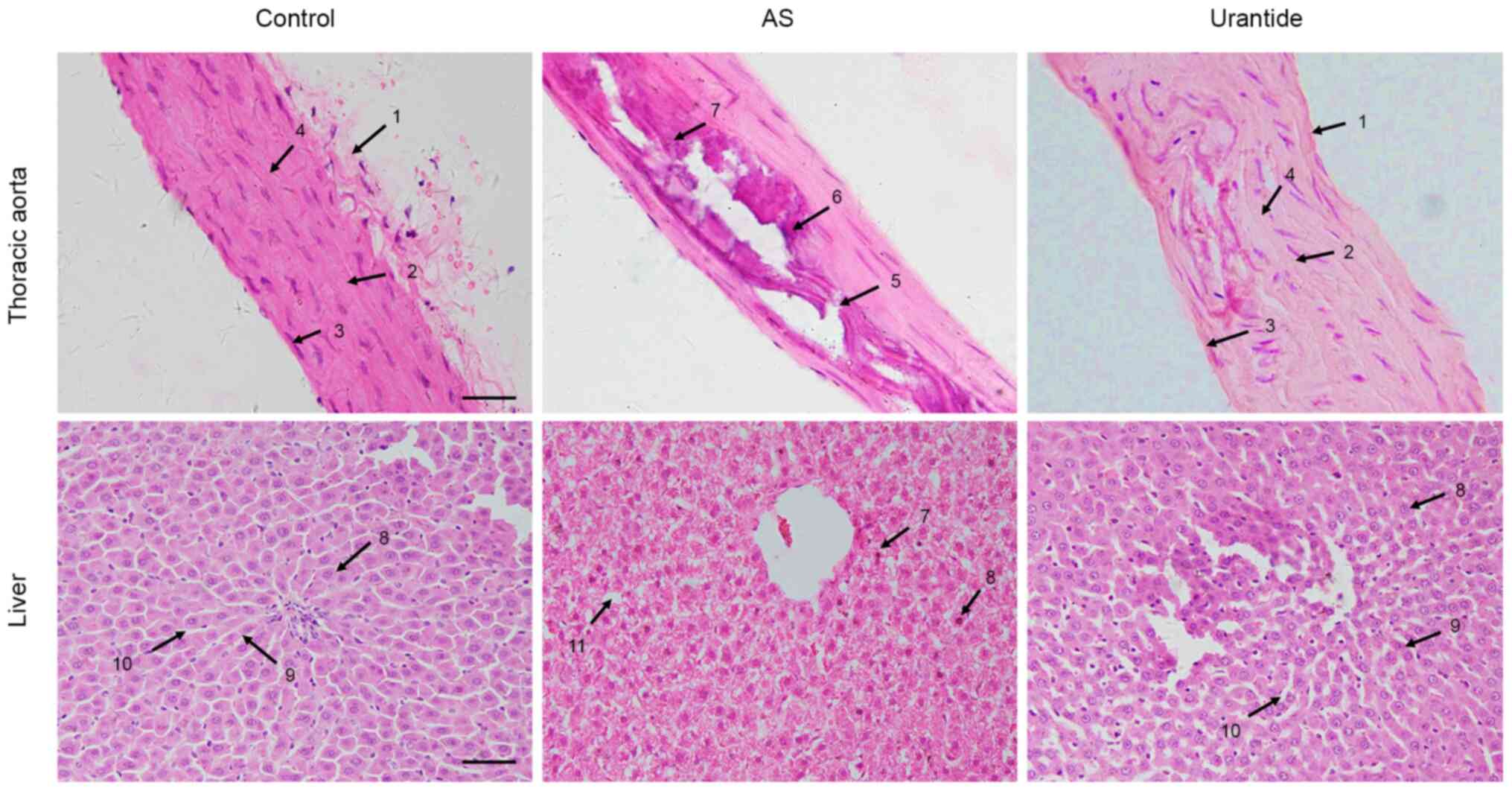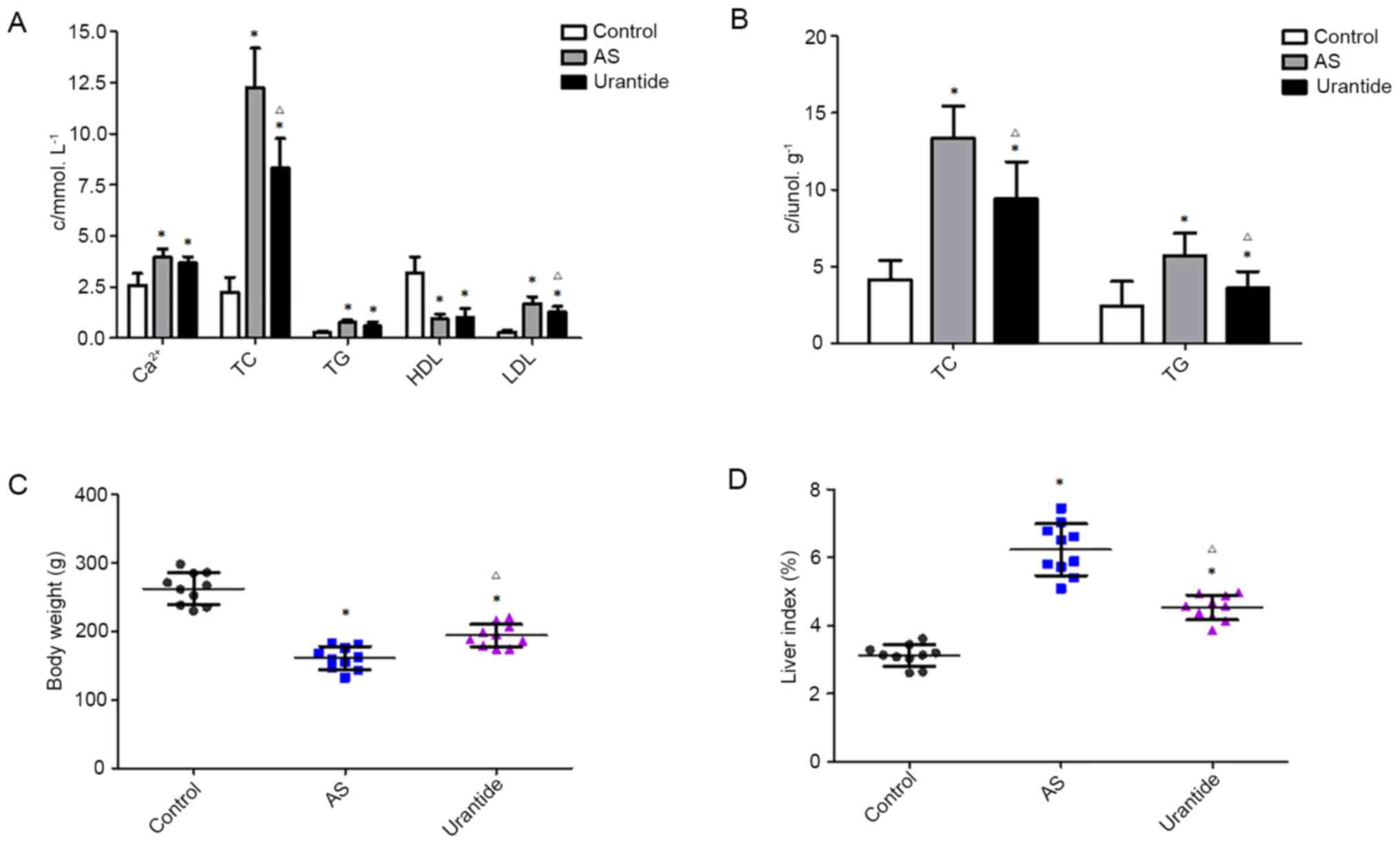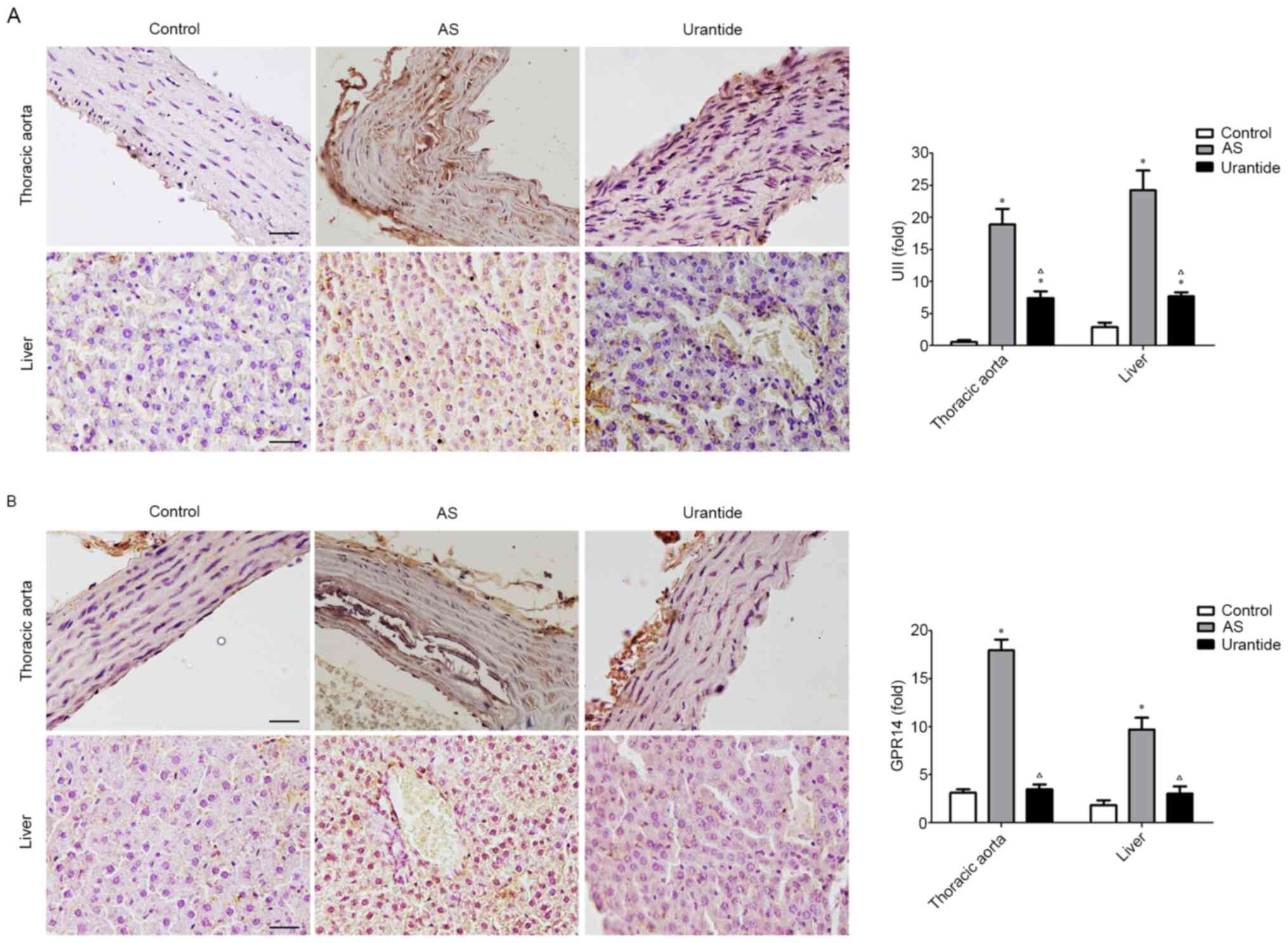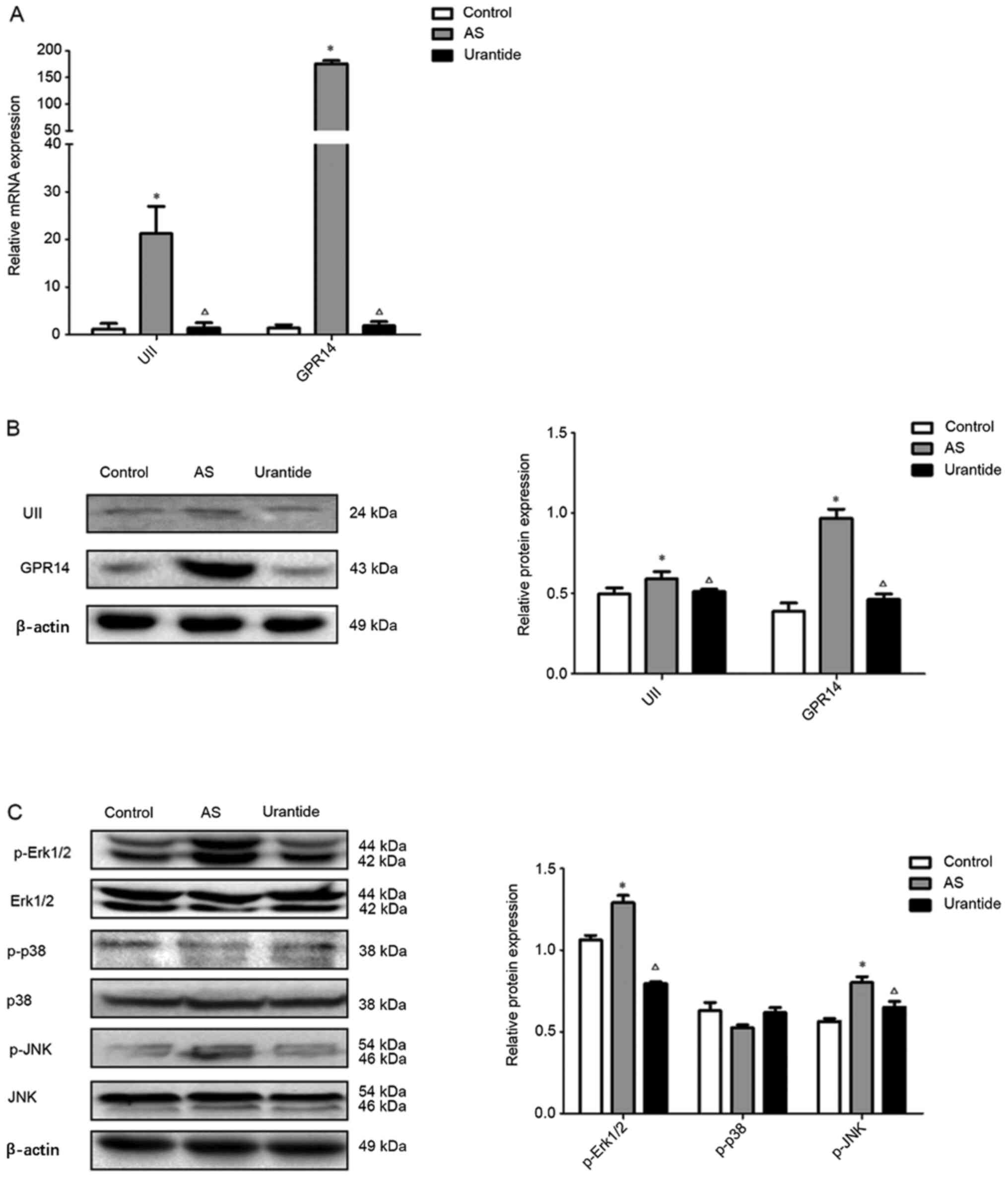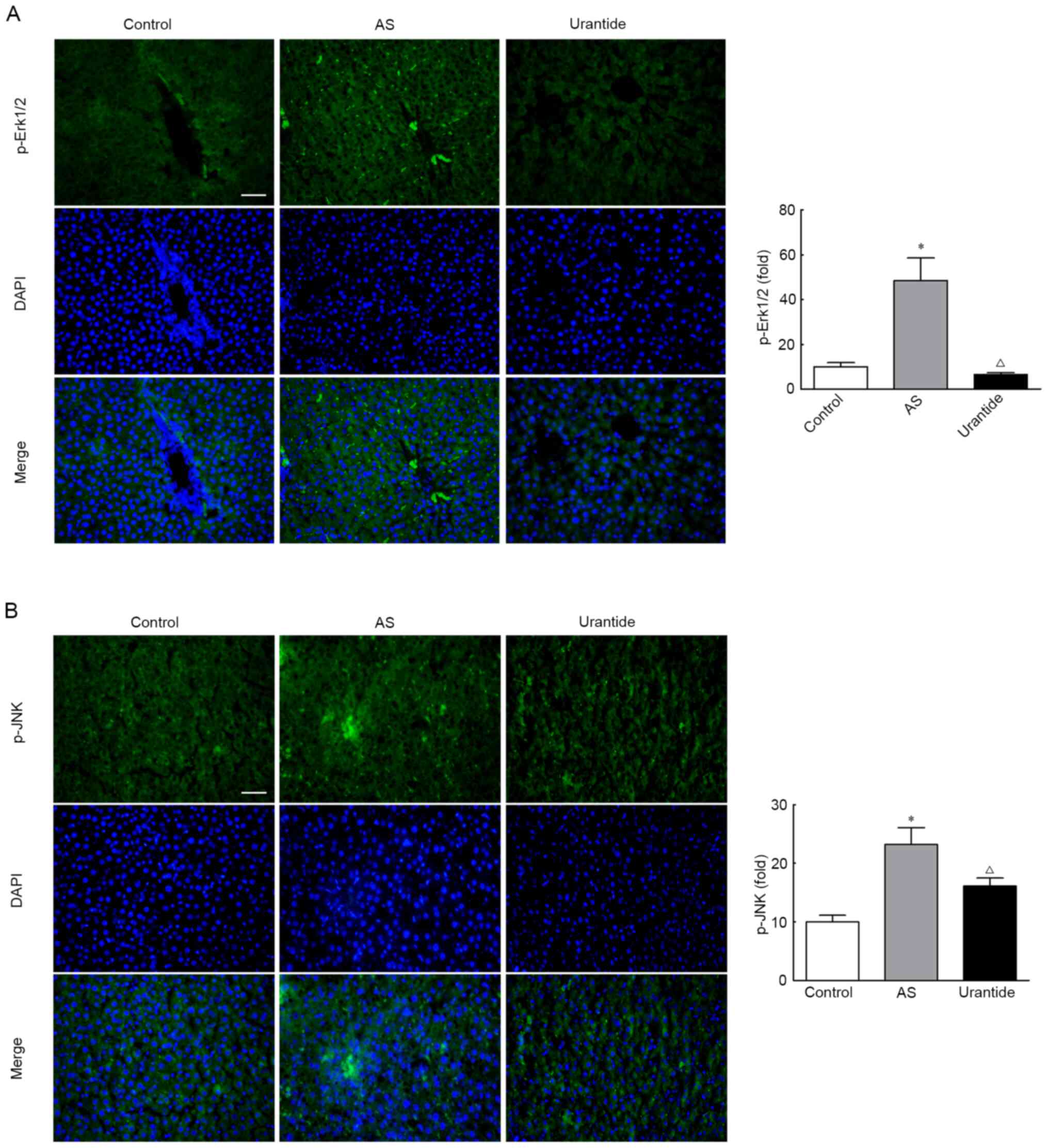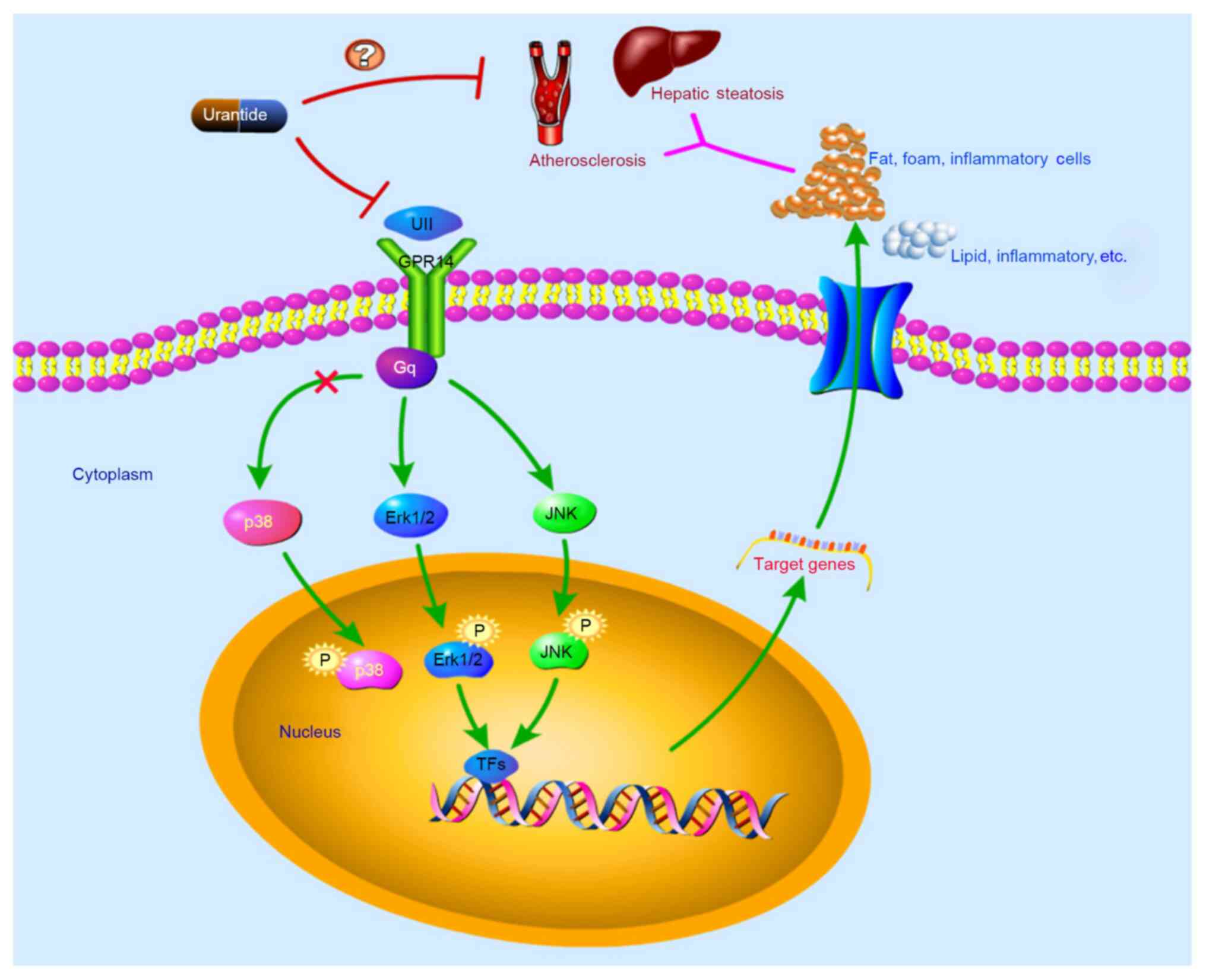|
1
|
Gaudio E, Nobili V, Franchitto A, Onori P
and Carpino G: Nonalcoholic fatty liver disease and
atherosclerosis. Intern Emerg Med. 7 (Suppl 3):S297–S305. 2012.
View Article : Google Scholar : PubMed/NCBI
|
|
2
|
Guth S, Windler E, Leise U and Bamberger
CM: Ultrasound Diagnosis of Hepatic Steatosis as a Surrogate for
Atherosclerosis. Ultrasound Int Open. 2:E27–E31. 2016. View Article : Google Scholar : PubMed/NCBI
|
|
3
|
Kapuria D, Takyar VK, Etzion O, Surana P,
O'Keefe JH and Koh C: Association of Hepatic Steatosis With
Subclinical Atherosclerosis: Systematic Review and Meta-Analysis.
Hepatol Commun. 2:873–883. 2018. View Article : Google Scholar : PubMed/NCBI
|
|
4
|
Ross B, McKendy K and Giaid A: Role of
urotensin II in health and disease. Am J Physiol Regul Integr Comp
Physiol. 298:R1156–R1172. 2010. View Article : Google Scholar : PubMed/NCBI
|
|
5
|
Brancaccio D, Limatola A, Campiglia P,
Gomez-Monterrey I, Novellino E, Grieco P and Carotenuto A: Urantide
conformation and interaction with the urotensin-II receptor. Arch
Pharm (Weinheim). 347:185–192. 2014. View Article : Google Scholar : PubMed/NCBI
|
|
6
|
Svistunov AA, Tarasov VV, Shakhmardanova
SA, Sologova SS, Bagaturiya ET, Chubarev VN, Galenko-Yaroshevsky
PA, Avila-Rodriguez MF, Barreto GE and Aliev G: Urotensin II:
Molecular Mechanisms of Biological Activity. Curr Protein Pept Sci.
19:924–934. 2018. View Article : Google Scholar : PubMed/NCBI
|
|
7
|
Bigeard J and Hirt H: Nuclear Signaling of
Plant MAPKs. Front Plant Sci. 9:4692018. View Article : Google Scholar : PubMed/NCBI
|
|
8
|
Keshet Y and Seger R: The MAP kinase
signaling cascades: A system of hundreds of components regulates a
diverse array of physiological functions. Methods Mol Biol.
661:3–38. 2010. View Article : Google Scholar : PubMed/NCBI
|
|
9
|
Ziltener P, Mueller C, Haenig B, Scherz MW
and Nayler O: Urotensin II mediates ERK1/2 phosphorylation and
proliferation in GPR14-transfected cell lines. J Recept Signal
Transduct Res. 22:155–168. 2002. View Article : Google Scholar : PubMed/NCBI
|
|
10
|
Zhao J, Yu QX, Kong W, Gao HC, Sun B, Xie
YQ and Ren LQ: The urotensin II receptor antagonist, urantide,
protects against atherosclerosis in rats. Exp Ther Med.
5:1765–1769. 2013. View Article : Google Scholar : PubMed/NCBI
|
|
11
|
Zhao J, Xie LD, Song CJ, Mao XX, Yu HR, Yu
QX, Ren LQ, Shi Y, Xie YQ, Li Y, et al: Urantide improves
atherosclerosis by controlling C-reactive protein, monocyte
chemotactic protein-1 and transforming growth factor-β expression
in rats. Exp Ther Med. 7:1647–1652. 2014. View Article : Google Scholar : PubMed/NCBI
|
|
12
|
Gou SH, Liu BJ, Han XF, Wang L, Zhong C,
Liang S, Liu H, Qiang Y, Zhang Y and Ni JM: Anti-atherosclerotic
effect of Fermentum Rubrum and Gynostemma pentaphyllum mixture in
high-fat emulsion- and vitamin D3-induced atherosclerotic rats. J
Chin Med Assoc. 81:398–408. 2018. View Article : Google Scholar : PubMed/NCBI
|
|
13
|
Huang ZY and Yang PY, Almofti MR, Yu YL,
Rui YC and Yang PY: Comparative analysis of the proteome of left
ventricular heart of arteriosclerosis in rat. Life Sci.
75:3103–3115. 2004. View Article : Google Scholar : PubMed/NCBI
|
|
14
|
Li X, Li X, Luo R, Wang W, Wang T and Tang
H: Detection of KIT genotype in pigs by TaqMan MGB real-time
quantitative polymerase chain reaction. DNA Cell Biol. 37:457–464.
2018. View Article : Google Scholar : PubMed/NCBI
|
|
15
|
Livak KJ and Schmittgen TD: Analysis of
relative gene expression data using real-time quantitative PCR and
the 2(-Delta Delta C(T)) Method. Methods. 25:402–408. 2001.
View Article : Google Scholar : PubMed/NCBI
|
|
16
|
Lu YW, Zhu YC, Zhang L, Li P, Yang J and
Wen XD: Ilexgenin A enhances the effects of simvastatin on
non-alcoholic fatty liver disease without changes in simvastatin
pharmacokinetics. Chin J Nat Med. 16:436–445. 2018.PubMed/NCBI
|
|
17
|
Targher G, Bertolini L, Padovani R,
Rodella S, Zoppini G, Zenari L, Cigolini M, Falezza G and Arcaro G:
Relations between carotid artery wall thickness and liver histology
in subjects with nonalcoholic fatty liver disease. Diabetes Care.
29:1325–1330. 2006. View Article : Google Scholar : PubMed/NCBI
|
|
18
|
Di Minno MN, Di Minno A, Ambrosino P,
Songia P, Tremoli E and Poggio P: Aortic valve sclerosis as a
marker of atherosclerosis: Novel insights from hepatic steatosis.
Int J Cardiol. 217:1–6. 2016. View Article : Google Scholar : PubMed/NCBI
|
|
19
|
Lee SB, Park GM, Lee JY, Lee BU, Park JH,
Kim BG, Jung SW, Jeong ID, Bang SJ, Shin JW, et al: Association
between non-alcoholic fatty liver disease and subclinical coronary
atherosclerosis: An observational cohort study. J Hepatol.
68:1018–1024. 2018. View Article : Google Scholar : PubMed/NCBI
|
|
20
|
Pearson D, Shively JE, Clark BR, Geschwind
II, Barkley M, Nishioka RS and Bern HA: Urotensin II: A
somatostatin-like peptide in the caudal neurosecretory system of
fishes. Proc Natl Acad Sci USA. 77:5021–5024. 1980. View Article : Google Scholar : PubMed/NCBI
|
|
21
|
Gabunia K, Jain S, England RN and Autieri
MV: Anti-inflammatory cytokine interleukin-19 inhibits smooth
muscle cell migration and activation of cytoskeletal regulators of
VSMC motility. Am J Physiol Cell Physiol. 300:C896–C906. 2011.
View Article : Google Scholar : PubMed/NCBI
|
|
22
|
Segain JP, Rolli-Derkinderen M, Gervois N,
Raingeard de la Blétière D, Loirand G and Pacaud P: Urotensin II is
a new chemotactic factor for UT receptor-expressing monocytes. J
Immunol. 179:901–909. 2007. View Article : Google Scholar : PubMed/NCBI
|
|
23
|
Watanabe T, Suguro T, Kanome T, Sakamoto
Y, Kodate S, Hagiwara T, Hongo S, Hirano T, Adachi M and Miyazaki
A: Human urotensin II accelerates foam cell formation in human
monocyte-derived macrophages. Hypertension. 46:738–744. 2005.
View Article : Google Scholar : PubMed/NCBI
|
|
24
|
Sun H, Zhang L and Shen D: Urantide
protects CCl4-induced liver injury via inhibiting GPR14 signal in
mice. Biotechnol Biotechnol Equip. 31:156–161. 2017. View Article : Google Scholar
|
|
25
|
Liang DY, Liu LM, Ye CG, Zhao L, Yu FP,
Gao DY and Wang YY, Yang ZW and Wang YY: Inhibition of UII/UTR
system relieves acute inflammation of liver through preventing
activation of NF-κB pathway in ALF mice. PLoS One. 8:e648952013.
View Article : Google Scholar : PubMed/NCBI
|
|
26
|
Liu LM, Zhao L, Liang DY, Yu FP, Ye CG, Tu
WJ and Zhu T: Effects of urotensin-II on cytokines in early acute
liver failure in mice. World J Gastroenterol. 21:3239–3244. 2015.
View Article : Google Scholar : PubMed/NCBI
|
|
27
|
Watanabe T, Kanome T, Miyazaki A and
Katagiri T: Human urotensin II as a link between hypertension and
coronary artery disease. Hypertens Res. 29:375–387. 2006.
View Article : Google Scholar : PubMed/NCBI
|
|
28
|
Cseh B, Doma E and Baccarini M: ‘RAF’
neighborhood: Protein-protein interaction in the Raf/Mek/Erk
pathway. FEBS Lett. 588:2398–2406. 2014. View Article : Google Scholar : PubMed/NCBI
|
|
29
|
Hwang HJ, Jung TW, Hong HC, Seo JA, Kim
SG, Kim NH, Choi KM, Choi DS, Baik SH and Yoo HJ: LECT2 induces
atherosclerotic inflammatory reaction via CD209 receptor-mediated
JNK phosphorylation in human endothelial cells. Metabolism.
64:1175–1182. 2015. View Article : Google Scholar : PubMed/NCBI
|
|
30
|
Reustle A and Torzewski M: Role of p38
MAPK in atherosclerosis and aortic valve sclerosis. Int J Mol Sci.
19:37612018. View Article : Google Scholar
|
|
31
|
Kardakaris R, Gareus R, Xanthoulea S and
Pasparakis M: Endothelial and macrophage-specific deficiency of
P38α MAPK does not affect the pathogenesis of atherosclerosis in
ApoE-/- mice. PLoS One. 6:e210552011. View Article : Google Scholar : PubMed/NCBI
|
|
32
|
Leprince J, Chatenet D, Dubessy C,
Fournier A, Pfeiffer B, Scalbert E, Renard P, Pacaud P, Oulyadi H,
Ségalas-Milazzo I, et al: Structure-activity relationships of
urotensin II and URP. Peptides. 29:658–673. 2008. View Article : Google Scholar : PubMed/NCBI
|
|
33
|
Guidolin D, Albertin G and Ribatti D:
Urotensin-II as an angiogenic factor. Peptides. 31:1219–1224. 2010.
View Article : Google Scholar : PubMed/NCBI
|
|
34
|
Wang T, Sun X, Cui H, Liu K and Zhao J:
The peptide compound urantide regulates collagen metabolism in
atherosclerotic rat hearts and inhibits the JAK2/STAT3 pathway. Mol
Med Rep. 21:1097–1106. 2020.PubMed/NCBI
|
|
35
|
Wang T, Xie YQ, Miao GX, Cui HP, Liu K, Li
Y, Li Y and Zhao J: Urotensin receptor antagonist urantide improves
atherosclerosis-related kidney injury by inhibiting JAK2/STAT3
signaling pathway in rats. Life Sci. 247:1174212020. View Article : Google Scholar : PubMed/NCBI
|















